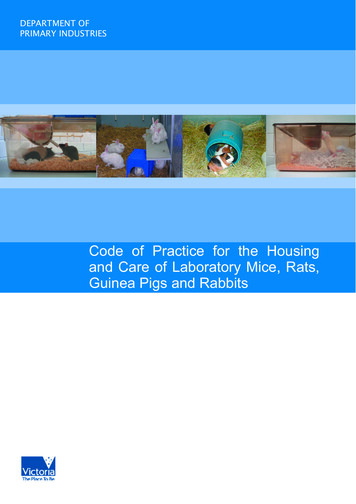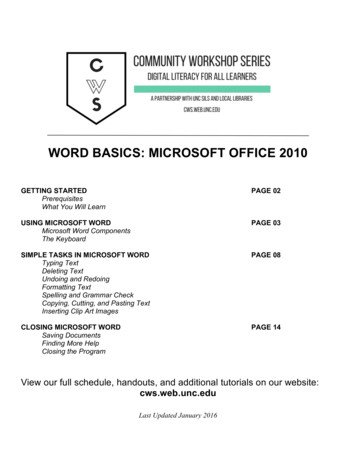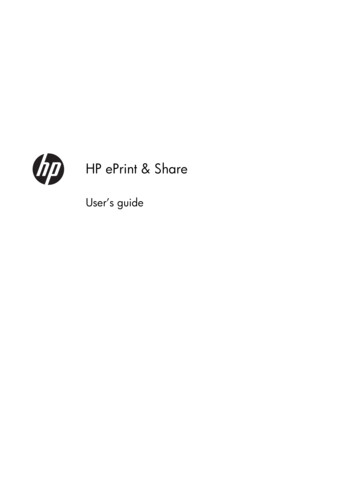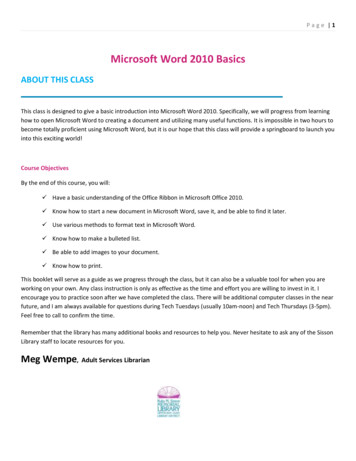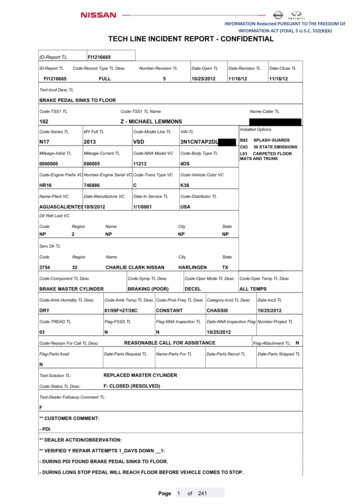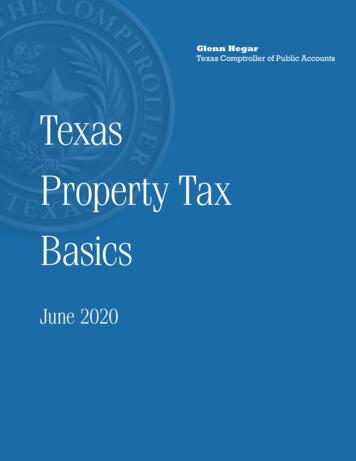
Transcription
Improving infrastructure delivery:Alliancing code of practiceGuidance on implementing Alliancing using NEC3 contracts
Infrastructure Client Group NEC Contracts 2016Improving infrastructure delivery:Alliancing Code of PracticeGuidance on implementing Alliancing usingNEC3 contractsGuidance on implementingAlliancing using NEC3 contracts1November 2016
Infrastructure Client Group NEC Contracts 2016Table of ContentsForeword3Acknowledgements41. Introduction52. Basis of implementation53. Measurement of cost74. Incentive model and performance measurement95. Risk allocation116. Management of the Alliance111ANNEX 1 – MATERIAL TO BE INCLUDED IN THE PARTNERING INFORMATION14ANNEX 2 – DISALLOWED COST16ANNEX 3A – EXAMPLE CONTRACT DATA, ECC18ANNEX 3B – EXAMPLE CONTRACT DATA, PSC28Guidance on implementingAlliancing using NEC3 contracts2November 2016
Infrastructure Client Group NEC Contracts 2016ForewordMore collaborative approaches and integrated team working have been actively supportedby the Infrastructure Client Group (ICG) and more widely by government and industry.Alliancing is one form of collaborative working that has been successfully adopted across arange of infrastructure organisations.The NEC Guidelines on Implementing Alliancing provide another positive step in thedevelopment and use of collaboration. The NEC3 is established as a contract model forcollaborative arrangements. This report builds on this position by providing clear andvaluable guidance on how to use the NEC3 for alliance arrangements and on the documentsthat should be developed in preparing the terms of an alliance agreement. In doing so, theguidelines build on the previous ICG Alliancing Best Practice material and Code of Practicefor Alliancing.The ICG actively promotes the sharing of best practice across infrastructure. This suite ofreports on Alliancing accomplish this by effectively consolidating learning from a range ofexamples and making proven best practice available to any organisation considering ordeveloping an alliance.Andy Mitchell, Chair, Infrastructure Client Group and CEO, Thames Tideway TunnelGuidance on implementingAlliancing using NEC3 contracts3November 2016
Infrastructure Client Group NEC Contracts 2016AcknowledgementsInfrastructure Client Group and NEC Contracts wish to thank the following for producing theGuidance on implementing the Alliancing Code of Practice using NEC3 contracts:Members of the drafting team:Peter Higgins, PD Consult and Chairman of the NEC Contract Drafting BoardIan Heaphy, IN Construction Consulting and Consultant with NEC Contractsand members of the Alliance Referencing Group for their input and commentsDale Evans, Anglian Water @one AllianceJohn Grimm, Anglian Water @one AllianceNeilan Perumal, Skanska, @one AllianceSimon Murray, Acumen7 NetworkDavid Holmes, CarillionDavid O’Neil, Highways EnglandInfrastructure Projects Authority (IPA)Steve Hudson, HS2Charles Jensen, Institution of Civil EngineersSimon Vaughan, JCP ConsultancyMike Pollard, Network RailGeoff Gilbert, Transport for LondonJon Allan, UK Power NetworksRekha Thawrani, NEC ContractsIndependent input by:Michael Meenaghan, Anglian Water Services LimitedGuidance on implementingAlliancing using NEC3 contracts4November 2016
Infrastructure Client Group NEC Contracts 20161. IntroductionThe Infrastructure Client Group Alliancing Code of Practice sets out best practice under fourelements of Alliancing – deciding to Alliance, creating an Alliance, delivering an Alliance andsustaining an Alliance. The section on creating an Alliance sets out the issues to beaddressed in preparing the terms of the Alliance agreement. This note provides moredetailed guidance on that aspect, by describing the documents that need to be created toprepare an Alliance contract using the NEC3 conditions of contract.This paper considers five areas where more detailed guidance is thought to be necessary.These are basis of implementation, measurement of cost, incentive model and performance measurement risk allocation, and management of the Alliance.2. Basis of implementationThe Alliance is created by the Employer entering into an individual NEC3 contract with eachAlliance Partner. The NEC3 is a suite of contracts that allows all members of the Alliance tobe procured on consistent terms and conditions that encourage the proactive collaborationthat is a prerequisite for alliancing. The NEC3 also contains a secondary option – X12Partnering – which is used to create multi-party partnering arrangements and is ideal tosupport the creation of an Alliance.The Alliance Partners may include Consultants to provide design and other services, Contractors to carry out construction work, and where in-house capability exists,detailed design work, Suppliers of Plant and Materials that are key to the works or where value can becreated by the early and consistent engagement of strategic vendors, existing maintenance Contractors and / or other Contractors whose work interfaceswith the work of the Alliance, and maintainers and / or operators of the assets created by the Alliance whose input mayhelp generate increased whole life cost through reduced operation and maintenancecosts.These Partners may be engaged directly by the Employer, or some of these Partners maybe brought in through subcontracts. The subcontracts which bring in further Alliance Partnerswill also use NEC3 forms of contract including Option X12 (see Figure 1).Guidance on implementingAlliancing using NEC3 contracts5November 2016
Infrastructure Client Group NEC Contracts 2016NEC3 has contract forms that can be used to engage each and every one of these partiesincluding Engineering and Construction Contract (ECC) and Subcontract (ECS), Professional Services Contract (PSC), Supply Contract (SC), Term Service Contract (TSC).Annex 3 contains examples of the Contract Data entries needed for the Contractorappointment under ECC and Consultant under PSC. These set out the essential entries, butfurther secondary options can be added where appropriate. If the NEC3 Supply Contract orTerm Service Contract are required to include suppliers in the Alliance, Contract Data shouldbe prepared using the same approach. When using these examples, care should be taken toverify that the needs of the Alliance have been fully covered.The Alliance may be created to meet a specific project need, or it may be created for aprogramme of works. In either case, the Alliance will be created through the Employerentering into NEC3 contracts with each of the Alliance Partners. When using NEC3contracts there is no need to create a separate overarching Alliance agreement as all thenecessary contractual, commercial and procedural requirements for the Alliance will becontained in each individual NEC3 contract.The scope of the works to be carried out and the outcomes expected from each Partner,along with the purpose of the Alliance, commitments, minimum requirements, andbehaviours of the Alliance Partners are set out in the appropriate Works/ Service/ SupplyInformation / Scope. This should not be prescriptive in defining what each Partner isrequired to do, as the Partners are expected to collaborate in identifying the most efficientway of achieving the outcomes required. This will be achieved by allocating work to the partywho is best placed to carry it out as decided by the Alliance.The scope of the works to be carried out by the Partners would, for a programme of works,identify the programme, and possibly include for the addition of further works as and whenthe need for those works became identified. The Alliance Partners would be engaged underthe NEC3 contract to provide their services for the entire project or programme. The contractwould, therefore, include all the provisions necessary to manage the relationship betweenthe Partners before, during and after the provision of individual works.On complex or evolving Alliances, consideration will need to be given to the instruction ofadditional work and the introduction of new Partners into the Alliance. A mechanism will beneeded to allow the creation of new and / or the modification of existing incentives, to link theperformance of the new Partners with the existing.The Partnering Information forms part of secondary Option X12 (Partnering) and allows thejoint working arrangements to be described in detail. A suggested contents list for thePartnering Information is contained in Annex 1. Where further tiers of the supply chain areengaged by the Alliance Partners these contracts will, where appropriate, also includesecondary Option X12 and the Partnering Information.Guidance on implementingAlliancing using NEC3 contracts6November 2016
Infrastructure Client Group NEC Contracts 2016The Partnering Information and the appropriate Works / Services / Supply Information /Scope will need to be carefully drafted to ensure they do not create any conflicts betweenthe Alliance Partner’s obligations to collaborate as part of the Alliance and the requirementsof their own specific contract. Guidance on the preparation of these documents is given inthe NEC3 guidance notes and published ’how to’ guides.Consideration will also need to be given to intellectual property rights (IPR) in relation to thedata brought into the Alliance by the Partners. It will need to be clear who owns such IPRand when it can be reused by Alliance members. Any information, created by the Alliance,that relates to the construction, operation and management of the completed assets mustbecome the intellectual property of the Employer.Figure 1 – Alliance contractual structure using NEC3 contracts3. Measurement of costFull open book accounting is considered a key principle in any Alliance agreement and theNEC3 applies open book, cost reimbursable procedures through the selection of mainOption E.The Partnering Information should require each Alliance Partner to report their costs in aconsistent format and feed this information into a single data system that all Partners haveaccess to. The Partnering Information should also include an explanation of how costs areto be validated, with assurance undertaken both by Partners and the Employer. The focusshould be on making the Alliance responsible for the first tier of audits to encourage thecorrect behaviours in the reporting of cost and the identification and removal of anyunrecoverable costs, prior to presentation to the Employer.Consideration will need to be given to the cost of accommodation, either on or off site andwhether provided by the Alliance Partners and / or the Employer. Matters which need to bedetermined include Co-location – one of the key drivers for successful alliancing is co-location of theEmployer and Partners in a shared office. If a shared office is to be used, thenGuidance on implementingAlliancing using NEC3 contracts7November 2016
Infrastructure Client Group NEC Contracts 2016consideration has to be given as to who will provide this; the Employer or an AlliancePartner. Whoever provides the office accommodation the costs should form part ofthe cost of the Alliance. Where an Alliance Partner provides site accommodation, this would be included aspart of the Partner’s cost and therefore part of the cost of the Alliance. Where members of the Alliance work out of their own offices, the method of recoveryof the accommodation costs for these resources by the Alliance Partner must beestablished. This may be through an agreed percentage of resource cost, adaily/monthly rate or a simple lump sum. Where resources are office based but work within Alliance provided accommodationfor a period of time, rules will need to be put in place to determine when theseresources become ’based’ in the Alliance provided accommodation and no longerattract a charge for accommodation in the Partner’s own offices.One of the key issues to consider will be the level of recovery of overheads and profit on thework carried out by the Alliance Partners. In order to drive performance in Alliances manyusers restrict the recovery of overheads and profit on the turnover of work carried out by theAlliance Partners. The Partners should only recover additional profit by achieving Employerobjectives, rather than simply carrying out work. Restricting or removing overheads and profiton turnover discourages Partners from seeking a greater share of the work or beinginefficient in how they deliver the works so as to generate increased turnover and thereforeprofit and overhead recovery. This approach supports one of the principle benefits ofAlliances, which is the ability to select the best Partner / person for each task and to avoidone to one supervision.The recovery of overhead and profit can be addressed in a number of different ways and theapproach adopted will in part be dependent upon the nature of the Alliance, its duration andmaturity. In some alliances overheads and profit are removed completely, whilst in othersthey only apply to limited elements of the Partner’s costs and / or at a reduced level(commonly excluding profit). The Alliance Partners are still able to recover their overheadsand profit but this is through the Alliance incentive model.If it is intended to restrict overhead and profit recovery under the ECC or TSC contracts, andmake it recoverable through the Alliance incentive model, the Employer should fix the feepercentages in Contract Data part 2. For the PSC contract, which does not include a fee,Consultants should be required to provide within their tender submission a build-up of theircosts, to demonstrate that the Time Charge does not include a contribution towards businessoverhead and profit, or only includes the percentage determined by the Employer (as for theContractor).Some of the NEC3 contracts used to create the Alliance (ECC, TSC) include the concept of’Disallowed Cost’. These are costs which have been incurred by the relevant Partner, butought not to have been incurred and are therefore not reimbursed. At the creation of theAlliance, the extent to which these Disallowed Costs should remain or be modified must bedecided. The more elements of cost that remain as disallowed, the greater the incentive oneach Partner to concentrate on their own costs, rather than those of if the Alliance. Removalof Disallowed Costs allows the Partners to concentrate on cost efficiency, with peer pressureGuidance on implementingAlliancing using NEC3 contracts8November 2016
Infrastructure Client Group NEC Contracts 2016used to reduce wasted costs. A list of the Disallowed Costs present under the ECC, andguidance on issues to consider when determining whether they should be modified or not isincluded at Annex 2. An example clause providing for the adjustment of disallowed costs isincluded in Annex 3 as a suggested Z Clause.4. Incentive model and performance measurementThe incentive model will be a key driver of success for the Alliance. It will follow the approachset out in the Code of Practice.The intent of the Alliance is to achieve agreed customer or project outcomes and theincentive model and performance measurement regime should directly link to theachievement of the Employer’s required outcomes, whilst still achieving mandatoryrequirements such as health and safety and environmental performance. The performancemeasurement regime must be compatible with the contracts that create the Alliance; furtherguidance on measurement criteria and the use of leading and lagging measures is availablefrom the Infrastructure Client Group.The incentive model is included in the Partnering Information through reference to the’incentive schedule’ in the Partnering Information. The incentive schedule will provide adetailed description of how the model is to be operated to achieve Alliance objectives.The incentive model is intended to generate financial savings through delivering theEmployers required outcomes for a lower cost than the Employer’s Budget; these savingswill be shared between the Alliance Partners based on the achievement of performancetargets.The incentive model should be self-funding with the savings created by the Alliance formingthe available financial return that is shared between the Partners. When creating the Allianceusers will need to consider what costs are to be included in the incentive model, these mayinclude the costs of all Alliance Partners, the costs of the further supply chain members, Employer costs, projected whole life costs and operating cost if applicable and other costs which could be influenced by Alliance decisions – for example utility costsor third-party compensation claims.When considering what costs will form part of the incentive model the key factor will be tomake sure they mirror the costs allowed for in the Employer’s Budget so that a true like forlike comparison can be made when determining the financial performance of the Alliance.If the Employer's Budget is not set prior to contract award, details of how the Budget is to beestablished must be set out in the contract, together with the action to be taken if the budgetcannot be agreed by all Partners. This would normally be to terminate the Alliance – forGuidance on implementingAlliancing using NEC3 contracts9November 2016
Infrastructure Client Group NEC Contracts 2016example, clauses covering the agreement of the Budget and the replacement of AlliancePartners are included in Annex 3 as a suggested Z Clause.The compensation event process in the individual contracts does not affect cost as these arecost reimbursable contracts, but still need to operate in relation to time, enabling theCompletion Date in the individual Partner contracts to be changed. These events do notchange the Employer’s Budget; the Alliance is required to deal with the consequences ofthese events within the budgetary constraint set by the Employer.However, the contract will also need to contain a mechanism for dealing with changes to theEmployer’s Budget for certain defined events. These are events that the Employer hasdecided are outside the control or influence of the Partners, but could have such an effect oncosts that, if left as an Alliance risk, would damage the incentive mechanism. Carefulconsideration must be given to any link between the change mechanisms that operate at theAlliance level and at the compensation event process at contract level to ensure that theywork together effectively. An example Z clause providing for the adjustment of the Budget for’strategic risk events’ is included in Annex 3.The incentive model includes targets to be achieved by Alliance Partners. If these are to beestablished after the award of contracts, a methodology for deciding these targets must beincluded within the Partnering Information.On completion of the project, the Alliance costs are compared to the Employer’s Budget andthe gain or pain is established. This is allocated to the Alliance Partners in the proportionsstated in the incentive model based on the achievement of stated performance requirements.The method for measuring performance against the specified targets is set out in thePartnering Information as Key Performance Indicators (KPI’s) with a level to be achieved setfor each KPI. The measurement of performance needs to be made as objective as possibleto avoid the risk of disputes as to whether the required level of performance has beenachieved. Longer term alliances may in addition make use of behavioural measures focusedon sustaining the alliance.Where an Alliance operates at a programme level the incentive mechanism normallyoperates on an aggregated basis across all work in the programme or at a sub programmelevel. There may be project level incentivisation as well, but consideration needs to be giventhe level of work and behaviours that will be created through the use of multiple tiers ofincentivisation.When an Alliance operates over multiple years consideration should be given to theassessment and award of gain or pain share at stages during the Alliance so as to create anongoing incentive to drive performance of the Partners. There is risk on long-term projectsor programmes that if the incentive is only assessed at the end it becomes too remote fromthe teams delivering the Alliance, some of whom may change during the life of the Alliance.Also at a corporate level the Partners cannot ’bank’ any savings created until the end of theAlliance and this can be a particular issue depending on how overheads and profit havebeen dealt with, as the creation of savings may be the Partners’ only opportunity to recovertheir overheads and profit. Staged assessments of incentivisation can take place on anannual basis or at the end of individual projects or packages of work.Guidance on implementingAlliancing using NEC3 contracts10November 2016
Infrastructure Client Group NEC Contracts 2016To avoid creating unhelpful motivations, a cap and/or collar may be placed on the gain orpain to be suffered by each Partner. An additional clause providing for the payment of anyoverspend, including a cap, if required, is included in Annex 3 as a suggested Z Clause.5. Risk allocationAn objective of the Alliance should be to create a process for identifying risks and decidingthe actions required of the individual Partners to reduce or mitigate them so as to minimiseits impact on the Alliance as a whole. This is best achieved by having risk shared whereverpossible so that all Partners have a vested interest in risk management. If the costs resultingfrom specific risks are allocated to individual Partners, this is likely to motivate Partners toconsider their own interests ahead of those of the Alliance.There may be a need to amend the standard allocation of risk under the NEC3 contractsused to engage the Alliance Partners to reflect this revised risk allocation. However, as theunderpinning contracts should be the cost reimbursable options the changes required shouldbe limited. An example of where the risk allocation may need to be modified is given by thecommentary on Disallowed Costs in the previous section on costs.How and where risk / contingency monies are held also needs careful consideration. TheEmployer when creating the Alliance may wish to include allowances for risk within theEmployer’s Budget and / or they may choose to hold some or all of the risk monies outsidethe Budget. If a risk event, held outside of the Budget, occurs an adjustment would need tobe made to compensate. An example additional clause to provide for the adjustment of theBudget is included in Annex 3 as a suggested Z Clause.Particular concern needs to be paid to the question of ’insurable risks’. These are risks forwhich insurance cover is normally carried by Contractors and Consultants. Depending on thenature of the Alliance it may well be beneficial for these risks to be covered through a projectinsurance policy taken out by the Employer. If not, these risks will be left with the individualPartners who will each need to cover the risk through their own insurance policies.If the individual Partners are to provide their own insurance policies, consideration will needto be given as to whether policy excesses are to be included as an Alliance cost or a costborne by the Alliance Partners. The contract would need an amendment if the excess wasto be an Alliance cost; a suggested Z clause is included in Annex 3. The management of anyclaims made under the Partner’s own policies could be problematic and needs carefulconsideration and control. The insurer will seek to keep its cost a minimum, regardless ofthe impact on the remainder of the Alliance. Additional costs could be incurred throughdelays, and the remediation the insurer is prepared to accept may not be the optimum onefor the project.6. Management of the AlliancePartnering InformationMost of the information which the Employer wishes to specify for the management of theAlliance relationship should be included within the Partnering Information. This sets out howthe parties work together in managing the relationship and co-operate to best achieveGuidance on implementingAlliancing using NEC3 contracts11November 2016
Infrastructure Client Group NEC Contracts 2016Alliance objectives. A suggested contents list for the Partnering Information is contained inAnnex 1.If the core team has not been established as part of the formation of the Alliance, theprocess for creating this and selecting the members on the basis of right person for the roleand the avoidance of ‘one to one supervision’ will need to be included in the PartneringInformation.In order to maximise the benefits of collaboration in the Alliance a number of Alliance wideprocesses should be developed. These will include early warnings and a common risk register, a common master programme; and common procedures for cost capture, reporting and forecasting.Alliances commonly introduce procedures for the resolution of disagreements prior tomatters being referred to adjudication, such as the use of structured issue escalation /negotiation process, early neutral evaluation and dispute avoidance boards. Considerationshould be given the creation of such approaches in the Partnering Information. Suchprocess cannot, in the UK, remove the ability of any party to take a dispute to adjudication atany time, but are generally effective in allowing contentious matters to be resolved within theAlliance, without the need for formal dispute resolution processes, which are likely to bedamaging to the Alliance.Further issues may also need to be addressed in the creation of the Alliance. Procedure for replacement of Alliance member. This could be insolvency, poorperformance by the supplier or realisation that the supplier does not have thecapability needed for the project. In such case it would be necessary to introduce anew Partner, which would need to be agreed by all other Partners beforeappointment. The removal would be either by mutual agreement or through thetermination provisions in the appropriate contract. Use of BIM. NEC has published standard contract amendments to provide for the useof the CIC BIM protocol. Ownership of material produced by Alliance members. If ownership is to betransferred to the Employer, an additional clause would be needed. An exampleclause is given in Annex 3. Processes to encourage the generation and sharing of innovation, best practice, andknowledge amongst the Alliance Partners. Operation of a project bank account or the adoption of other processes to ensure afair payment regime is implemented. If a project bank account approach is selected itwould be sensible to operate a single Alliance bank account and appropriate contractamendments for this option are set out in Annex 3.Guidance on implementingAlliancing using NEC3 contracts12November 2016
Infrastructure Client Group NEC Contracts 2016Role of the Project Manager and SupervisorThe role of the Project Manager, Service Manager and Supervisor and where they will sit inrelation to the Alliance needs to be considered. This is particularly important in respect ofthe Project Managers / Service Managers duties relating to change control and payment,where they have a duty to act impartially and often under the governance of the Employer.Commonly these functions are kept outside of the Alliance, but other activities such as riskmanagement and programming can be carried out by members of the Alliance.Accordingly, the Employer may choose to split the functions of the Project Manager / ServiceManager between an individual who is appointed directly by them and sits outside theAlliance, and a member of the Alliance. An alternative would be to have the same individualundertake both roles but with different governance dependent on the tasks beingundertaken.The role of the Supervisor is more commonly provided by a member of the Alliance or theduties are combined with other activities of Alliance members.Guidance on implementingAlliancing using NEC3 contracts13November 2016
Infrastructure Client Group NEC Contracts 2016Annex 1 – Material to be included in the Partnering Information Overriding purpose, role and the required behaviours for the Alliance – this will setthe scene for the Alliance in terms of Employer objectives and the rationale andbenefits expected by creating an Alliance delivery model. Customer outcomes / business objectives – the Employer will identify what benefitsthey want the Alliance to create and how this relates to their own objectives. End-to-end delivery process including key gateways, milestones and decision-makingresponsibility – this will provide details of the project (and / or programme) lifecycleincluding details of the project development, approval and delivery processes and therole the Alliance is intended to play in this. Organisation model including leadership roles – how the Alliance will be structuredand operate and how it will interface with the Employer’s existing business structure,including details over key roles and responsibilities. This will also coverestablishment of the core team and (Project) Board including job specifications. Collective decision making process – this will detail the decision-making process andwhat aspects will reside in the Alliance as opposed to being retained by theEmployer. It will also detail how collective decisions will be made – unanimous /majority etc. and will confirm who has the authority to commit Alliance members, theEmployer and the Alliance as a whole. Approach to integration / colocation – how the Alliance will integrate the activities ofthe different Alliance Partners and where the members of the Alliance will be basedincluding details of any co-located offices. How design and system integration will be managed within the Alliance. Role of Project Manager and Supervisor – will need to be defined including, who willbe responsible for appointing them (Employer, Alliance, Alliance Partner), theirresponsibilities, governance requirements and how they will interface
Infrastructure Client Group NEC Contracts 2016 Guidance on implementing Alliancing using NEC3 contracts 4 November 2016 Acknowledgements Infrastructure Client Group and NEC Contracts wish to thank the following for producing the Guidance on implementing the Alliancing Code of Practice using NEC3 contracts:



